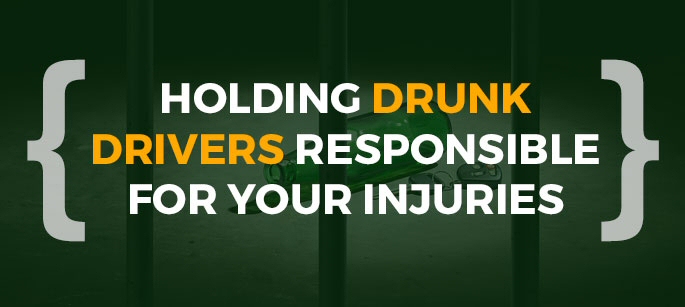When alcohol contributes to a car crash, the aftermath often brings confusion, stress, and questions about what happens next. For those injured or impacted, the steps taken in the early hours and days following the incident can influence the outcome of an insurance claim or legal case.
Collecting evidence is not just about documentation—it can serve as a foundation for holding the impaired driver accountable.
This guide by the Philadelphia drunk driving accident lawyers at The Levin Firm outlines what to do after a drunk driving accident, including key actions and types of evidence that may support a future claim and whether the injured party is seeking compensation or trying to understand legal options.
Get A Free Consultation Today!
Immediate Actions to Take After a Collision with a Drunk Driver
Safety is always the first priority after any crash. Once injuries have been assessed and emergency services contacted, the next step is documenting the event. Even if law enforcement is already on the way, specific actions taken before their arrival may help preserve valuable details.
Begin by photographing the scene from multiple angles, including all vehicles involved, license plates, and any visible damage. Include street signs, traffic lights, skid marks, and roadway conditions. These images may later assist in establishing the conditions of the crash and the sequence of events.
Avoid discussing fault with the other driver. If intoxication is suspected, remain calm and limit interaction. Allow police to handle the investigation. Their observations, including whether the other driver exhibits signs of impairment, will be recorded in the official police report.
If possible, take notes on what happened immediately before the crash. Include traffic flow, speed, road conditions, and other drivers' behavior. These details may fade quickly, and written notes created soon after the collision are often more reliable than later recollections.
Physical Evidence to Preserve from the Scene
Some evidence is best collected before the vehicles are moved or the debris is cleared. If safe to do so, collect or document items such as:
- Broken vehicle parts
- Shattered glass
- Damage to nearby property (guardrails, signs, poles)
- Clothing with visible damage or blood
- Any containers, open bottles, or paraphernalia near or inside the impaired driver's vehicle
This type of physical evidence can help support the claim that alcohol was a contributing factor in the collision. Detailed photographs with timestamps may be a strong substitute if proof cannot be preserved directly.
Also consider environmental details, such as weather, lighting conditions, and roadway layout, as they can impact a crash. Capture wide-angle shots that encompass these features.
Preserving physical evidence helps establish what occurred and can reinforce claims that might otherwise rely only on written reports or testimony.
Witness Statements and Contact Information
Independent witnesses often play a significant role in impaired driving cases. They can confirm or challenge statements made by drivers, clarify the sequence of events, and add objectivity to the narrative.
After the crash, look around for individuals who may have seen the events unfold. This could include pedestrians, nearby drivers, business owners, or residents. Approach respectfully and ask if they would share what they saw. If they agree, request their name and contact information.
Avoid pressuring anyone to give a formal statement on the spot. Instead, ask if they will speak with an attorney or investigator later. A calm, respectful approach is more likely to result in cooperation.
Details that are often helpful from a witness include:
- The behavior of the impaired driver before the crash
- Signs of swerving, speeding, or running signals
- Observations about the driver's condition (e.g., slurred speech, unsteady movements)
- Comments made by the driver after the crash
Witness statements are especially valuable when they support visual or physical evidence already collected. They can also provide support when the impaired driver disputes the claims made against them.
Police Reports and Legal Documentation
The police report created after a drunk driving crash often becomes one of the most important records in a legal case. It includes the officer’s initial findings, notes about driver behavior, sobriety test results, and any citations or arrests.
Contact the law enforcement agency that responded to the crash to obtain a copy of this report. Many jurisdictions may have a waiting period before the report becomes available. A copy can often be requested online, by mail, or in person.
Key items to review within the police report include:
- The officer's description of the impaired driver
- Any field sobriety or breathalyzer results
- Witness statements collected by law enforcement
- Diagrams or summaries of the crash
- Official determination of fault or contributing factors
This report provides credibility when negotiating with insurance companies and can serve as foundational evidence if the case proceeds to litigation.
If criminal charges were filed against the impaired driver, court records and charging documents may also become part of the documentation process. These records are often public and can be requested through the appropriate court clerk.
Medical Records and Injury Documentation
Seeking immediate medical attention serves two purposes: protecting health and establishing a documented link between the crash and any injuries. Even injuries that seem minor can evolve into more serious conditions over time. Delays in care may create doubts about whether the injuries were related to the accident.
Medical documentation may include:
- Emergency room intake records
- Imaging results (X-rays, CT scans, MRIs)
- Diagnosis summaries
- Physician notes
- Treatment plans and prescriptions
- Records of follow-up appointments
- Long-term care referrals (physical therapy, rehabilitation)
Maintain copies of all medical records, including billing statements and insurance summaries. These documents help establish the scope of harm and the resulting financial losses.
Sometimes, a treating physician may provide a written opinion regarding the impact of injuries on future mobility, work capacity, or daily life. This type of evidence may assist in calculating damages for pain, suffering, and lost earning capacity.
Digital and Technological Evidence
Digital evidence has become increasingly helpful in proving fault and supporting a claim. In cases involving impaired driving, several forms of technology can document what occurred before, during, and after the crash.
- Dashcams. If a dashcam had been installed in either vehicle, it might have recorded the events leading to the collision. Some dashcams also capture audio, including the impaired driver’s speech and behavior.
- Surveillance footage. Nearby businesses or traffic cameras may have recorded the accident. These recordings are often deleted on a rolling basis, so requests should be made promptly. Time is usually limited—some systems overwrite video within 24 to 72 hours.
- Phone location data. If there is reason to believe the impaired driver was using a phone or was at a bar before the crash, location data may provide a timeline of events. However, obtaining this data type often requires legal procedures such as subpoenas or court orders.
- Social media posts. Posts made by the impaired driver before or after the crash may be relevant. For example, public posts showing alcohol consumption before driving could support a claim of negligence. Similarly, any statements made online after the incident could impact liability or credibility.
Ensure that all digital evidence is preserved in its original format. Do not edit or alter video files; maintain logs of how and when they were collected. This chain of custody may be relevant later.
Blood Alcohol Content (BAC) and Sobriety Test Results
When alcohol consumption is suspected in a collision, law enforcement typically conducts tests to confirm impairment. These results are not only relevant to criminal charges but also carry weight in civil claims for damages.
Blood alcohol content (BAC) is measured through breath, blood, or urine tests. The legal limit for most drivers is 0.08 percent, though commercial drivers and individuals under the legal drinking age may be held to stricter thresholds depending on jurisdiction. A result above the legal limit is often considered evidence of impairment.
In addition to BAC results, police officers may conduct field sobriety tests at the scene. These tests assess balance, coordination, and the ability to follow instructions. While subjective, the officer’s observations are typically recorded in the police report and may include slurred speech, bloodshot eyes, and delayed reaction times.
A personal injury attorney may request the full incident report and any related arrest records to obtain this evidence in a civil case. Access to BAC test results or body cam footage may sometimes require a subpoena or discovery request, especially if the evidence is part of an ongoing criminal prosecution.
Including these records in a civil case can reinforce the argument that the impaired driver acted recklessly and contributed directly to the collision and resulting injuries.
Compensation and Legal Options After Being Hit by a Drunk Driver
Once evidence has been collected, the next step often involves evaluating legal options and potential compensation. While no outcome is guaranteed, the strength and organization of the evidence can influence whether a settlement is offered and how damages are calculated.
Common categories of compensation include:
- Medical expenses, both current and projected
- Rehabilitation and therapy costs
- Lost wages or reduced earning capacity
- Property damage
- Physical pain and emotional distress
- Loss of enjoyment of life
In many jurisdictions, punitive damages may also be available in drunk driving cases. These are not designed to compensate the injured person but to punish the impaired driver for reckless conduct. Punitive damages are less common but may be awarded in cases involving gross negligence or intentional wrongdoing.
Insurance companies often attempt to settle claims before litigation begins. Strong evidence increases the likelihood of a fair offer during these negotiations. A lawsuit may follow if the insurer denies the claim or offers an amount that does not reflect the full extent of damages.
Timing matters. Each state imposes a statute of limitations that limits how long an injured party has to file a claim. The deadline may vary based on whether the claim involves injury, property damage, or wrongful death. Once the deadline passes, legal action may no longer be an option.
When to Consult a Drunk Driving Accident Attorney

Legal representation may be beneficial when the injuries are severe, liability is disputed, or the other driver’s insurance company offers a settlement that does not cover long-term losses. An attorney experienced in accidents involving intoxicated drivers can help interpret the available evidence, request additional records, and build a claim reflecting the full scope of harm.
Many law firms offer free initial consultations to review the details of a potential claim. During this conversation, the attorney may ask questions about how the crash occurred, the evidence collected, and whether any deadlines are approaching.
Engaging legal counsel early can help preserve records that may be lost or deleted over time. For example, businesses may erase security footage within a few days, and phone records may be difficult to obtain without formal legal procedures.
In addition, an attorney may issue a letter of representation to the other driver’s insurer, which may pause direct contact from adjusters and allow the injured party to focus on medical recovery.
Even if the injured person is unsure whether to pursue a claim, a consultation may clarify available legal paths and help determine the appropriate next steps.
The period after a drunk driving accident brings unexpected stress, medical decisions, and financial concerns. While the legal process can take time, early evidence collection plays a key role in supporting claims and helping injured individuals protect their rights.
From photos and witness names to police records and digital files, each piece of evidence serves a distinct purpose. Proper documentation strengthens the claim and encourages fair treatment from insurers and courts.

Legal Help for Victims of Drunk Driving Accidents
Those injured in alcohol-related crashes often face long-term physical, emotional, and financial consequences. At The Levin Firm, our drunk driving injury attorneys work closely with clients and their families to help them pursue compensation for the full range of losses resulting from the crash.
These may include medical bills, rehabilitation costs, lost income, reduced future income, permanent disabilities, disfigurement, cognitive injuries, psychological distress, and other damages tied to long-term recovery.
Our approach involves thorough investigation, close coordination with healthcare professionals, and a commitment to pursuing the best possible outcome. We collaborate with physicians, mental health providers, financial planners, and care specialists to understand each client’s needs and prepare a case supported by clear documentation.
Get A Free Consultation Today!
Each case we accept is treated with individual attention and strategic focus. From collecting evidence to negotiating with insurance companies, we aim to protect the interests of those harmed by impaired drivers.
If you or someone close to you has been injured in a drunk driving accident in Pennsylvania, New Jersey, or Florida, contact The Levin Firm to discuss your options. Our team is available by phone at (215) 825-5183 or through our secure online form.
